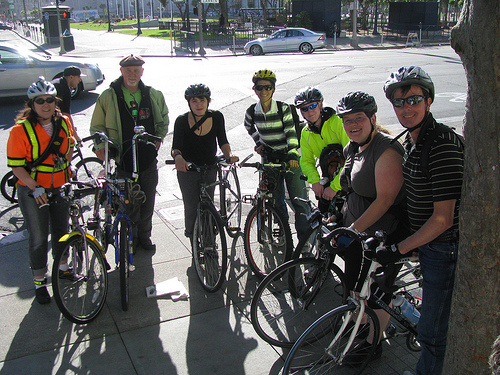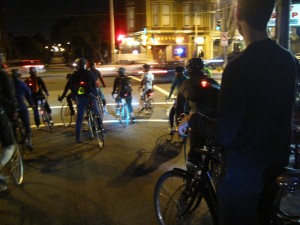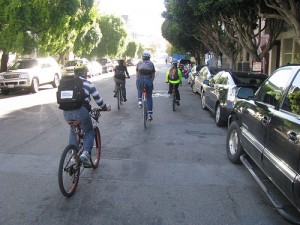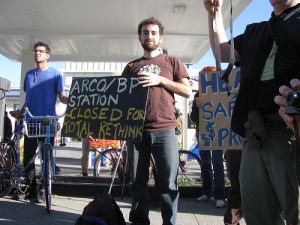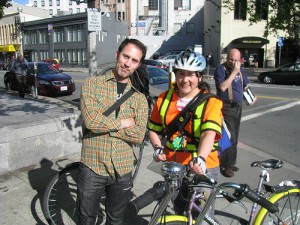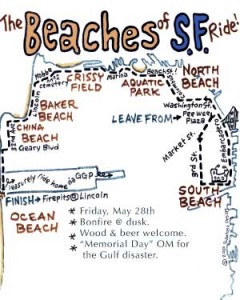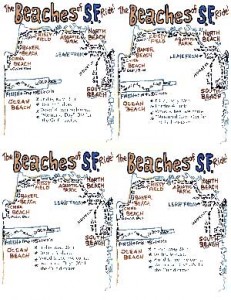You know what’s interesting about our contemporary bike culture? All these proliferating group rides. It seems that Critical Mass no longer has a monopoly on the fantastic idea of riding somewhere on bikes together!
There’s the San Jose Bike Party, of course, and the brand new East Bay Bike Party. But there are also lots of smaller rides — numbering anywhere from 10-50 people — that meet on a regular or semi-regular basis to try variations on this tactic.
For example, there’s the super fun Butterlap. It meets every Wednesday at the Ferry Building at 6:30pm, and takes off along the Embarcadero before heading up to the Palace of Fine Arts and points beyond (it’s the same excellent route each time), before looping back to the Mission. A word of warning: don’t bring your tank-like 3-speed cruiser, like I did, or you will be sorry!
And this month saw the return of Critical Manners, the group bike ride that bills itself as a lawful, polite alternative to Critical Mass. Chris, Nio and I joined up with the other CM outside the library on Larkin, and a small group of about 15 of us rode together up through the Wiggle and into the park, stopping to visit the anti-Arco/BP protest at Fell & Diviz (also a new regular event, every Friday).
Along the way we stopped for most stop signs and all red lights, which was actually kind of a fun exercise for me. (However, I noticed that Chris was totally unable to get with the program, and continued to just blast right through every traffic stop he came to, as usual. Some people are just born scofflaws!*)
It might surprise some people to hear that I enjoyed Critical Manners, since I am a loud and strident supporter of Critical Mass. But I did have a good time, and I met some nice people. Personally, I think there is room in San Francisco for all kinds of rides for all kinds of people. Critical Manners will definitely appeal to those who are uncomfortable with Critical Mass’s habit of running red lights and generally raising a ruckus — and for those people, Critical Manners is a great chance to experience a group ride!
If you’re curious, I totally suggest tagging along on the next one. The folks who were there were nice and friendly, and they seem committed to keeping their ride going. They’ll be meeting every 2nd Friday of the month at Larkin and Grove at 5:30 or 6.
That said, there is a crucial ingredient that I feel is missing on these smaller rides, and that is sociability! When you’re riding single file, and only occasionally two abreast — basically any time you’re not taking the whole lane — it’s pretty hard to have a conversation. You certainly can’t mingle and socialize easily. Both Butterlap and Critical Manners in my experience weren’t the intensely social experience that Critical Mass is. The experience is much closer to a normal day biking around town. Which is to say: more or less solitary, marginalized, and dangerous.
That is really the great thing about Critical Mass: we bring a transformation to the city. One day a month, you can ride through San Francisco streets without feeling like you are some sort of second-class traffic citizen! And you can explore the city in the company of hundreds of others, and have long conversations while you do it — all without fear of being run down or slammed by a car door. It’s this experience of a city transformed that only a really large ride, like Critical Mass or the San Jose Bike Party, can bring. And that transformation is what it’s really all about.
May a thousand rides bloom!
* Many people are outraged at bicyclists that ride the way Chris and I habitually do, treating stop signs as yield signs and most red lights as yellow lights. I can see their point. Wouldn’t it be great if everyone obeyed the law? I suggest that we start by insisting that those driving the most dangerous vehicles pay strict attention to the letter of the law — and that means obeying the speed limit at all times! This seemingly universal habit that car drivers have of completely ignoring speed limits is not only rude, corrupt, and evidence of a lack of respect for the police and the rule of law, it is also deadly! Speeding directly causes thousands of deaths and injuries each year. Once we have all or most motorists driving the speed limit, then we can turn our attention to the relatively minor problem of bicycle scofflaws.
